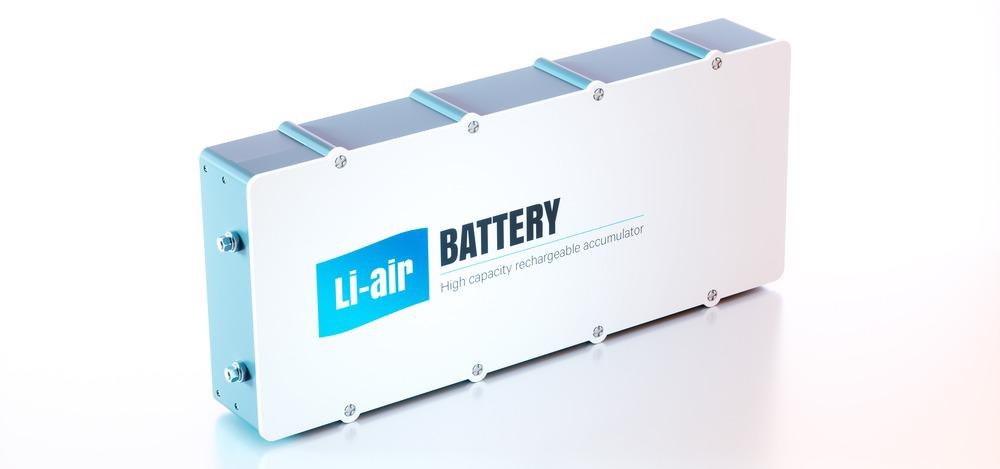
Image Credit: petrmalinak/Shutterstock.com
Lithium-air batteries were originally proposed in the 1970s as a possible power source for battery electric vehicles and hybrid electric vehicles. Theoretical specific energy of nearly 11,700 Wh kg-1, close to the value known for liquid fuels, renders rechargeable Li-air (Li-O2) batteries as top candidates for electric vehicles.
How Does a Li-O2 Battery Work?
Voltage is usually created by a Li-O2 cell with help from oxygen (O2) molecules at the positive electrode. This O2, after reacting with the positively charged lithium ions, forms lithium peroxide (Li2O2), generating electric energy. Electrons are then drawn out of the electrode. This kind of battery is discharged if Li2O2 formation is saturated.
Pros and Cons of Li-O2 Batteries
The Li-O2 battery possesses an ultrahigh theoretical energy density and is a promising electrical energy storage system (EES).
However, the practical applications of Li-O2 batteries are mostly hindered by low energy efficiency, short cycle life, and poor rate capability.
Recent Research on Li-O2 Batteries
The low energy efficiency and limited cycle life of Li-O2 batteries are caused by the lack of cathode catalyst materials, resulting in sluggish reactions for both oxygen reduction and evolution reactions (ORR and OER) at thermodynamic potentials and slow mass transport on the cathode. Most of the active catalysts reported for such phenomena are extremely expensive, including platinum and gold.
A group of scientists led by Professor Mohammad Asadi at the Illinois Institute of Technology (IIT) has been working to design such a catalyst in the US.
Previously, Trimolybdenum phosphide nanocatalysts (Mo3P) had shown promise as a catalyst for similar reactions. Owing to the unique structure of Mo3P, its surface provides a high density of molybdenum (Mo) active sites with unique electronic properties. This means it is characterized by low work function and high-density d-orbital electrons at Fermi energy. This can be a promising factor for electrocatalysis.
An evaluation of its performance in a lithium-air battery was a starting point for this research. The battery operated at discharge and charge overpotentials of 80 and 270 millivolts (mV), among the lowest reported for a lithium-air battery when ran with the Mo3P catalyst. The Li-O2 battery retained almost 100% of its initial performance after 1200 cycles.
During cycling, the researchers found that after a close analysis of the battery's performance, a stable lithium carbonate layer (Li2CO3) is formed around the anode. According to the researchers, this Li2CO3 layer would prevent other unwanted reactions with constituents in both the air and the electrolyte.
The catalyst formed a layer of molybdenum oxide (MoO), which was predicted to enhance battery performance further.
The researchers found that Mo3P nanoparticles possess nearly the same catalytic activities for both ORR and OER. With faster charge transfer kinetics and high intrinsic catalytic activity for both ORR and OER, this catalyst outperformed most of the existing catalysts that have been studied.
The researchers also performed Density Functional Theory (DFT) calculations, which confirmed that ORR and OER's enhanced activities were caused by a kinetically stable MoO monolayer on the Mo-terminated Mo3P surface sites. This presence of the MoO monolayer was also confirmed by experimental characterization later. However, the battery lost performance after 1000 cycles, which was attributed to charge redox mediator deactivation.
The Superior Catalytic Properties of Trimolybdenum Phosphide
Video Credit: Advanced Science News/YouTube.com
Future Work
In their paper, the researchers at IIT stated that the surface-reconstructed Mo3P catalyst, with a kinetically stable oxidized overlayer, can lead to a massive sustainable energy storage system advancement based on the electronic and structural properties of Mo3P discovered in the examined Li-O2 battery system.
The team believes that further research towards developing the Mo3P catalyst could contribute to a considerable development for energy storage using Li-O2 battery systems.
References and Further Reading
A. Kondori, Z. Jiang, M. Esmaeilirad, M. Tamadoni Saray, A. Kakekhani, K. Kucuk, P. N. M. Delgado, S. Maghsoudipour, J. Hayes, C. S. Johnson, C. U. Segre, R. Shahbazian-Yassar, A. M. Rappe, and M. Asadi. (2020) Kinetically Stable Oxide Overlayers on Mo3P Nanoparticles Enabling Lithium–Air Batteries with Low Overpotentials and Long Cycle Life. Adv. Mater. 2004028. https://doi.org/10.1002/adma.202004028
C. Wang, Z. Xie, and Z. Zhou. (2019) Lithium-air batteries: Challenges coexist with opportunities. APL Materials. 7, 040701. https://doi.org/10.1063/1.5091444
Hitchins, M. (2020) A new catalyst for lithium-air batteries. [Online] PV Magazine. Available at: https://www.pv-magazine.com/2020/11/27/a-new-catalyst-for-lithium-air-batteries/
ZSW. [Online] Fundamental research for Lithium-air batteries. Available at: https://www.zsw-bw.de/en/projects/batteries/fundamental-research-for-lithium-air-batteries.html
IFL Science. [Online] Lithium-Air: A Battery Breakthrough Explained. Available at: https://www.iflscience.com/technology/lithium-air-battery-breakthrough-explained/
Disclaimer: The views expressed here are those of the author expressed in their private capacity and do not necessarily represent the views of AZoM.com Limited T/A AZoNetwork the owner and operator of this website. This disclaimer forms part of the Terms and conditions of use of this website.